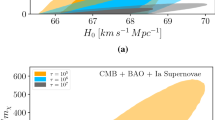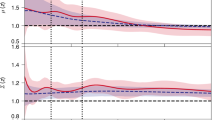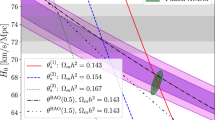Abstract
Modifications of general relativity generically contain additional degrees of freedom that can mediate forces between matter particles. One of the common manifestations of a fifth force in alternative gravity theories is a difference between the gravitational potentials felt by relativistic and non-relativistic particles, also known as ‘the gravitational slip’. In contrast, a fifth force between dark matter particles, owing to dark sector interaction, does not cause a gravitational slip, making the latter a possible ‘smoking gun’ of modified gravity. Here we point out that a force acting on dark matter particles, as in models of coupled quintessence, would also manifest itself as a measurement of an effective gravitational slip by cosmological surveys of large-scale structure. This is linked to the fact that redshift-space distortions owing to peculiar motion of galaxies do not provide a measurement of the true gravitational potential if dark matter is affected by a fifth force. Hence, it is extremely challenging to distinguish a dark sector interaction from a modification of gravity with cosmological data alone. Future observations of gravitational redshift from galaxy surveys can help to break the degeneracy between these possibilities, by providing a direct measurement of the distortion of time. We discuss this and other possible ways to resolve this important question.
This is a preview of subscription content, access via your institution
Access options
Access Nature and 54 other Nature Portfolio journals
Get Nature+, our best-value online-access subscription
$29.99 / 30 days
cancel any time
Subscribe to this journal
Receive 12 digital issues and online access to articles
$119.00 per year
only $9.92 per issue
Buy this article
- Purchase on Springer Link
- Instant access to full article PDF
Prices may be subject to local taxes which are calculated during checkout


Similar content being viewed by others
Data availability
Data sharing is not applicable to this article as no datasets were generated or analysed during the current study.
References
Perlmutter, S. et al. Measurements of omega and lambda from 42 high redshift supernovae. Astrophys. J. 517, 565–586 (1999).
Riess, A. G. et al. Observational evidence from supernovae for an accelerating universe and a cosmological constant. Astron. J. 116, 1009–1038 (1998).
Lovelock, D. The Einstein tensor and its generalizations. J. Math. Phys. 12, 498–501 (1971).
Lovelock, D. The four-dimensionality of space and the einstein tensor. J. Math. Phys. 13, 874–876 (1972).
Horndeski, G. W. Second-order scalar-tensor field equations in a four-dimensional space. Int. J. Theor. Phys. 10, 363–384 (1974).
Deffayet, C., Gao, X., Steer, D. A. & Zahariade, G. From k-essence to generalised Galileons. Phys. Rev. D 84, 064039 (2011).
Amendola, L., Kunz, M. & Sapone, D. Measuring the dark side (with weak lensing). J. Cosmol. Astropart. Phys. 0804, 013 (2008).
Daniel, S. F., Caldwell, R. R., Cooray, A. & Melchiorri, A. Large scale structure as a probe of gravitational slip. Phys. Rev. D 77, 103513 (2008).
Zhang, P., Liguori, M., Bean, R. & Dodelson, S. Probing gravity at cosmological scales by measurements which test the relationship between gravitational lensing and matter overdensity. Phys. Rev. Lett. 99, 141302 (2007).
Song, Y.-S. et al. Complementarity of weak lensing and peculiar velocity measurements in testing general relativity. Phys. Rev. D 84, 083523 (2011).
Amendola, L., Kunz, M., Motta, M., Saltas, I. D. & Sawicki, I. Observables and unobservables in dark energy cosmologies. Phys. Rev. D 87, 023501 (2013).
Amendola, L. et al. Cosmology and fundamental physics with the Euclid satellite. Living Rev. Relativ. 16, 6 (2013).
Amendola, L. et al. Cosmology and fundamental physics with the Euclid satellite. Living Rev. Relativ. 21, 2 (2018).
Wetterich, C. The Cosmon model for an asymptotically vanishing time dependent cosmological ’constant’. Astron. Astrophys. 301, 321–328 (1995).
Zlatev, I., Wang, L.-M. & Steinhardt, P. J. Quintessence, cosmic coincidence, and the cosmological constant. Phys. Rev. Lett. 82, 896–899 (1999).
Amendola, L. Coupled quintessence. Phys. Rev. D 62, 043511 (2000).
Barros, B. J., Amendola, L., Barreiro, T. & Nunes, N. J. Coupled quintessence with a ΛCDM background: removing the σ8 tension. J. Cosmol. Astropart. Phys. 01, 007 (2019).
Song, Y.-S., Hollenstein, L., Caldera-Cabral, G. & Koyama, K. Theoretical priors on modified growth parametrisations. J. Cosmol. Astropart. Phys. 04, 018 (2010).
Motta, M., Sawicki, I., Saltas, I. D., Amendola, L. & Kunz, M. Probing dark energy through scale dependence. Phys. Rev. D 88, 124035 (2013).
Zucca, A., Pogosian, L., Silvestri, A. & Zhao, G.-B. MGCAMB with massive neutrinos and dynamical dark energy. J. Cosmol. Astropart. Phys. 05, 001 (2019).
Castello, S., Grimm, N. & Bonvin, C. Rescuing constraints on modified gravity using gravitational redshift in large-scale structure. Phys. Rev. D 106, 083511 (2023).
Kunz, M. & Sapone, D. Dark energy versus modified gravity. Phys. Rev. Lett. 98, 121301 (2007).
Battye, R. A. & Pearson, J. A. Effective action approach to cosmological perturbations in dark energy and modified gravity. J. Cosmol. Astropart. Phys. 07, 019 (2012).
Kaiser, N. Clustering in real space and in redshift space. Mon. Not. R. Astron. Soc. 227, 1–27 (1987).
Bonvin, C. & Durrer, R. What galaxy surveys really measure. Phys. Rev. D 84, 063505 (2011).
Yoo, J., Fitzpatrick, A. L. & Zaldarriaga, M. A new perspective on galaxy clustering as a cosmological probe: general relativistic effects. Phys. Rev. D 80, 083514 (2009).
Challinor, A. & Lewis, A. The linear power spectrum of observed source number counts. Phys. Rev. D 84, 043516 (2011).
Bonvin, C., Hui, L. & Gaztanaga, E. Asymmetric galaxy correlation functions. Phys. Rev. D 89, 083535 (2014).
McDonald, P. Gravitational redshift and other redshift-space distortions of the imaginary part of the power spectrum. J. Cosmol. Astropart. Phys. 11, 026 (2009).
Croft, R. A. C. Gravitational redshifts from large-scale structure. Mon. Not. R. Astron. Soc. 434, 3008–3017 (2013).
Yoo, J., Hamaus, N., Seljak, U. & Zaldarriaga, M. Going beyond the Kaiser redshift-space distortion formula: a full general relativistic account of the effects and their detectability in galaxy clustering. Phys. Rev. D 86, 063514 (2012).
Gaztanaga, E., Bonvin, C. & Hui, L. Measurement of the dipole in the cross-correlation function of galaxies. J. Cosmol. Astropart. Phys. 01, 032 (2017).
Beutler, F. & Di Dio, E. Modeling relativistic contributions to the halo power spectrum dipole. J. Cosmol. Astropart. Phys. 07, 048 (2020).
Bonvin, C. & Fleury, P. Testing the equivalence principle on cosmological scales. J. Cosmol. Astropart. Phys. 05, 061 (2018).
Sobral-Blanco, D. & Bonvin, C. Measuring anisotropic stress with relativistic effects. Phys. Rev. D 104, 063516 (2021).
Sobral-Blanco, D. & Bonvin, C. Measuring the distortion of time with relativistic effects in large-scale structure. Mont. Not. R. Astron. Soc. Letters 519, 39 (2023).
Prat, J. et al. Dark energy survey year 3 results: high-precision measurement and modeling of galaxy–galaxy lensing. Phys. Rev. D 105, 083528 (2022).
Tutusaus, I., Sobral-Blanco, D. & Bonvin, C. Combining gravitational lensing and gravitational redshift to measure the anisotropic stress with future galaxy surveys. Phys. Rev. D 107, 083526 (2023).
Ivezić, v et al. LSST: from science drivers to reference design and anticipated data products. Astrophys. J. 873, 111 (2019).
Planck Collaboration Planck 2015 results. XIV. Dark energy and modified gravity. Astron. Astrophys. 594, A14 (2016).
Wang, J., Hui, L. & Khoury, J. No-go theorems for generalized chameleon field theories. Phys. Rev. Lett. 109, 241301 (2012).
Baldi, M. Clarifying the effects of interacting dark energy on linear and nonlinear structure formation processes. Mon. Not. R. Astron. Soc. 414, 116 (2011).
Khoury, J. & Weltman, A. Chameleon fields: awaiting surprises for tests of gravity in space. Phys. Rev. Lett. 93, 171104 (2004).
Hinterbichler, K. & Khoury, J. Symmetron fields: screening long-range forces through local symmetry restoration. Phys. Rev. Lett. 104, 231301 (2010).
Deffayet, C., Esposito-Farese, G. & Vikman, A. Covariant Galileon. Phys. Rev. D 79, 084003 (2009).
Deffayet, C., Pujolas, O., Sawicki, I. & Vikman, A. Imperfect dark energy from kinetic gravity braiding. J. Cosmol. Astropart. Phys. 1010, 026 (2010).
Linder, E. V. No slip gravity. J. Cosmol. Astropart. Phys. 03, 005 (2018).
Jelic-Cizmek, G., Lepori, F., Bonvin, C. & Durrer, R. On the importance of lensing for galaxy clustering in photometric and spectroscopic surveys. J. Cosmol. Astropart. Phys. 04, 055 (2021).
Alam, S. et al. Completed SDSS-IV extended Baryon Oscillation Spectroscopic Survey: Cosmological implications from two decades of spectroscopic surveys at the Apache Point Observatory. Phys. Rev. D 103, 083533 (2021).
Blake, C. et al. Galaxy And Mass Assembly (GAMA): improved cosmic growth measurements using multiple tracers of large-scale structure. Mon. Not. R. Astron. Soc. 436, 3089 (2013).
Zhao, G.-B. et al. The completed SDSS-IV extended Baryon Oscillation Spectroscopic Survey: a multitracer analysis in Fourier space for measuring the cosmic structure growth and expansion rate. Mon. Not. R. Astron. Soc. 504, 33–52 (2021).
Acknowledgements
We thank S. Castello, H. Mirpoorian, A. Silvestri and Z. Wang for useful discussions, and R. Durrer, K. Koyama and M. Kunz for their valuable feedback on the draft of this paper. C.B. acknowledges financial support from the Swiss National Science Foundation and from the European Research Council (ERC) under the European Union’s Horizon 2020 research and innovation programme (grant agreement number 863929; project title ‘Testing the law of gravity with novel large-scale structure observables’). L.P. is supported by the National Sciences and Engineering Research Council (NSERC) of Canada.
Author information
Authors and Affiliations
Contributions
The authors contributed equally to all aspects of the project and writing the paper.
Corresponding author
Ethics declarations
Competing interests
The authors declare competing interests.
Peer review
Peer review information
Nature Astronomy thanks Dragan Huterer and the other, anonymous, reviewer(s) for their contribution to the peer review of this work
Additional information
Publisher’s note Springer Nature remains neutral with regard to jurisdictional claims in published maps and institutional affiliations.
Supplementary information
Supplementary Information
Supplementary Discussion and Table 1.
Rights and permissions
Springer Nature or its licensor (e.g. a society or other partner) holds exclusive rights to this article under a publishing agreement with the author(s) or other rightsholder(s); author self-archiving of the accepted manuscript version of this article is solely governed by the terms of such publishing agreement and applicable law.
About this article
Cite this article
Bonvin, C., Pogosian, L. Modified Einstein versus modified Euler for dark matter. Nat Astron 7, 1127–1134 (2023). https://doi.org/10.1038/s41550-023-02003-y
Received:
Accepted:
Published:
Issue Date:
DOI: https://doi.org/10.1038/s41550-023-02003-y



